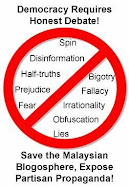
In his post, he wrote (bold emphasis mine):
The Pharaohs at that time were a bad lot. The Pharaoh was a tyrant and did many bad things. One of the biggest wrongs committed by the Pharaoh was that he divided the people into castes or groups. Here is the Quran :Tuan Syed was writing this to comment on caste politics in the MIC, caste within the Indian community in general, and how Rocky, (Editor-in-Chief of the Malay Mail) was "advised" by the Ministry for Home Affairs to avoid reporting such issues in the Malay Mail. He writes:
Surah 28:4 "Surely Pharaoh exalted himself in the land and divided the people into castes (shiah), weakening one party from the other; he slaughtered their sons and let their women live; surely he was one of the mischief-makers".
Dividing people into castes, favoured groups, elites and so on is an age old trick. The ultimate aim of all caste systems (in whatever shape or form) is economic hegemony. Someone wants to corner all the "dinaro" in the economy. It is a method of self preservation by the top dogs.
This is a real issue. It is a Malaysian issue too. Sweeping it under the rug will not make it go away.Tuan Syed makes some excellent points here. The caste system has been a great curse to Indians and Hindus all over the world. It continues to plague Malaysian Indians, even within the political parties that claim to represent them. He (and Rocky) are indeed right in bringing attention to it, and no one, not even the KDN, should question their right to comment on religious and cultural matters (even if it is not their own religion and culture). It is certainly a problem that all Malaysians need to discuss, be aware of and help solve.
The point about who can or cannot become a priest at the Hindu temple or become a member of the temple commitee is relevant. In other countries (the US for example) they have strict laws which make it illegal to discriminate against anyone based on their race or religion.
The irony that I want to draw your attention to is this: Does not "Dividing people into castes, favoured groups, elites and so on is an age old trick. The ultimate aim of all caste systems (in whatever shape or form) is economic hegemony. Someone wants to corner all the "dinaro" in the economy. It is a method of self preservation by the top dogs", pretty accurately describe what is happening in Malaysia under Umno/BN, not just the Indians? Don't we have an elite Umno/BN caste, which is able to do anything, i.e. murder, rape and plunder our nation with impunity? Don't we have a favoured group of crony capitalists who "corner all the "dinaro" in the economy" on behalf of their political masters? Don't we suffer from institutionalised and socialised bigotry in laws and attitudes that prevent Malaysians from certain ethnicities, religions (and political affiliations) from holding certain positions of responsibility? Don't we need (like "other countries, the US for example"), "strict laws which make it illegal to discriminate against anyone based on their race or religion"?
Finally, isn't Umno/BN continuing to "divide[d] the people into castes (shiah)", as seen in their post GE-12 strategy of sowing ethnic and religious hatred, distrust and fear, its most recent manifestation being the Umno/BN inspired cow head incident? Isn't Umno/BN doing this so that Malaysians will stop working with each other on issues of national importance, but instead get in line behind the respective BN party representing their race, thereby exalting BN in the land?
The smilarities between the pharoah and Umno/BN is so close, it's almost enough to make me believe that Tuan Syed is taking a backhanded shot at Umno/BN! Could this be? For another recent, possibly backhanded shot from a pro-Umno/BN blogger, read this damning indictment of Umno by Dato' Ariff at Sakmongkol AK47.
It's great that Tuan Syed can see the kuman* (microbe) across the sea, and is truly concerned about it. It would have been greater if he would see (and write about) the gajah (elephant) in front of our very eyes. Then again, perhaps he has! After all, the kuman can't fight back, can they, whereas the gajah might just stomp one to death!
Sincerely,
Malaysian Heart
* Kuman di seberang laut nampak, gajah di depan mata tak nampak - Malay proverb, literally "sees a microbe across the sea, but cannot see the elephant in front of the eyes". Used to refer to selective or biased criticisism or praise, or hypocrisy.
P.S. As an aside: Tuan Syed also wrote about the ancient Egyptian pharoah Akhenaten, and speculated about how his legacy was treated by the priests after he died. He wrote:
The priests had their revenge after Akhenatun died. First they reverted the system back to what it was. People had to "donate" grain to the temples. Then they tried to erase the memory of Akhenatun from Egyptian history. I think it was part of Egyptian belief that they had to carve huge statues of their dead Pharaohs. Akhenatun was no exception here. They made statues of him too - but they purposely disfigured the statues of Akhenatun.Some evidence to the contrary from here:
Hence the statues of Akhenatun have wide hips like a woman, they have breasts and have a distorted face. Lately some Egyptologists say that Akhenatun may have been deformed or suffered some physical handicaps. I dont think so. I think they just wanted to show their spite and purposely disfigured his appearance.
While Akhenaten led a reform on the Ancient Egyptian religion, he also revolutionized Egyptian art. He broke the conventions of Egyptian art by showing himself in warm family scenes with his wife and children, and portraying himself and the rest of the royal family in a much more human and naturalistic manner than any of his predescessors had. The most peculiar result of this art reform, however, was the portrayal of the physical characteristics of the pharaoh himself.It would seem that the "disfigured" portrayals of Akhenaten were actually created during his reign, and that the pharoah was responsible for his portrayal in that way. Furthermore, when the ancient Egyptians did not like a deceased pharoah, they expunged and excised his/her name and image from the historical record, as was experienced by Hatshepsut and Akhenaten himself. From here:
In sculptures and paintings of Akhenaten, he is shown as having a long, slender neck, a long face with a sharp chin, narrow, almond-shaped eyes, full lips, long arms and fingers, rounded thighs and buttocks, a soft belly, and enlarged breasts. His odd appearance was particularly prominent in art from the early part of the reign. [...]
Following Akenaten's death, a peaceful but comprehensive political, religious and artistic reformation returned Egyptian life to the norms it had followed previously during his father's reign. Much of the art and building infrastructure that was created during Akhenaten's reign was defaced or destroyed in the period immediately following his death. Stone building blocks from his construction projects were later used as foundation stones for subsequent rulers temples and tombs.From here:
I cannot find any evidence to suggest that the ancient Egyptians carved sculptures, however "disfigured", of dead pharoahs out of spite (I'll stand corrected on this if Tuan Syed can prove otherwise).With Akhenaten's death, the Aten cult he had founded gradually fell out of favor.[citation needed] Tutankhaten changed his name to Tutankhamun in Year 2 of his reign (1332 BC) and abandoned the city of Akhetaten, which eventually fell into ruin. His successors Ay and Horemheb disassembled temples Akhenaten had built, including the temple at Thebes, using them as a source of easily available building materials and decorations for their own temples.
Finally, Akhenaten, Neferneferuaten, Smenkhkare, Tutankhamun, and Ay were excised from the official lists of Pharaohs, which instead reported that Amenhotep III was immediately succeeded by Horemheb. This is thought to be part of an attempt by Horemheb to delete all trace of Atenism and the pharaohs associated with it from the historical record.[citation needed] Akhenaten's name never appeared on any of the king lists compiled by later Pharaohs and it was not until the late 19th century that his identity was re-discovered and the surviving traces of his reign were unearthed by archaeologists.
Note: All this does not affect in any way Tuan Syed's main argument. I offer this merely as an indicator of his standard of fact-checking, and credibility.






















No comments:
Post a Comment
How to Paste Text into Comment Boxes
Google seems to have disabled pasting text (including ctrl-v) into blogger comments boxes in Firefox. The good news is that:
1. You can still copy paste using Internet Explorer (I successfully tried it with IE7)
2. With Firefox, you can still "Drag and Drop" text into the comment form. I have successfully dragged and dropped text from MS Word, websites (HTML) and from ScribeFire (plain text and HTML). Just do the following:
a) reduce the size of the window you want to take the text from, and place it near the comment box
b) Highlight the required text with cursor
c) Click on the highlighted text and drag it over to the comment box and drop it there.
Happy commenting!